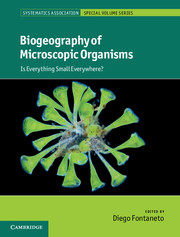Book contents
- Frontmatter
- Contents
- List of contributors
- Preface
- Part I Theoretical framework
- Part II Prokaryotes
- Part III Unicellular eukaryotes
- Part IV Pluricellular eukaryotes
- Part V Processes
- 15 Microbes as a test of biogeographic principles
- 16 A metacommunity perspective on the phylo- and biogeography of small organisms
- 17 Geographic variation in the diversity of microbial communities: research directions and prospects for experimental biogeography
- Index
- Systematics Association Publications
- Systematics Association Special Volumes
- Plate section
- References
17 - Geographic variation in the diversity of microbial communities: research directions and prospects for experimental biogeography
from Part V - Processes
Published online by Cambridge University Press: 05 August 2012
- Frontmatter
- Contents
- List of contributors
- Preface
- Part I Theoretical framework
- Part II Prokaryotes
- Part III Unicellular eukaryotes
- Part IV Pluricellular eukaryotes
- Part V Processes
- 15 Microbes as a test of biogeographic principles
- 16 A metacommunity perspective on the phylo- and biogeography of small organisms
- 17 Geographic variation in the diversity of microbial communities: research directions and prospects for experimental biogeography
- Index
- Systematics Association Publications
- Systematics Association Special Volumes
- Plate section
- References
Summary
Introduction
Traditionally, most ecologists understand the world from a human scale. Ecosystems are often understood as large visible units of the landscape, usually homogeneous land patches or a series of adjacent patches with intense flows of individuals, energy or biomass and nutrients. However, there is more in a landscape than meets the eye. An arguably homogeneous land patch within a landscape hosts many small ecosystems, or microhabitat patches, where many different communities of microbes dwell and interact. For example, imagine you are standing in a clearing of an open forest in a temperate region. A terrestrial ecologist studying macroscopic organisms would think he is looking at part of a single ecosystem. On the contrary, a microbial ecologist will identify a plethora of different ecosystems, including leaf litter of different degrees of humidity, the bark of each different tree and shrub species, treeholes, temporary puddles and pools, moss cushions of different life forms growing over different substrates, etc. Not to mention soil communities. In other words, a 1 ha clearing within a forest could be considered a whole landscape for many groups of microbes.
A key question in microbial ecology is thus whether the patterns and organisation of microbial communities differ from those of macroscopic organisms just in terms of scale or they are so radically different that the rules affecting macrobes cannot be extrapolated to microbes. The debate on this question extends to the biogeography of microorganisms.
- Type
- Chapter
- Information
- Biogeography of Microscopic OrganismsIs Everything Small Everywhere?, pp. 335 - 357Publisher: Cambridge University PressPrint publication year: 2011
References
- 10
- Cited by

